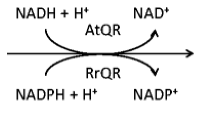Abstract
In the last few years, the use of enzymes for industrial purpose has revealed a rapid growth owing to the advantages they confer to conventional chemical methods. For example biocatalysts are highly specific and efficient and are able to produce chiral compounds.
Access this chapter
Tax calculation will be finalised at checkout
Purchases are for personal use only
Preview
Unable to display preview. Download preview PDF.
Similar content being viewed by others
References
D.A. Cowan, Biochemistry and molecular biology of the extremely thermophilic Archaebacteria, in: “Molecular Biology and Biotechnology of Extremophiles,” RA. Herbert, and R.J. Sharp, eds., New York: Chapman and Hall (1992).
D.A. Cowan, Biotechnology of the Archaea, TIBTECH 10:315–323 (1992)
C.R. Woese, Bacterial Evolution, Microbiol Rev. 51:221–271 (1987).
D.G. Searcy, The archaebacterial histone HTa, in: “Bacterial chromatin,” C.O. Gualerzi, and C.L. Pow, eds., Heidelberg: Springer-Verlag (1986).
J.K. Kristjansson, Thermophilic organisms as sources of thermostable enzymes, TIBTECH 7: 349–353 (1989).
K. Peek, L.D. Ruttersmith, R.M. Daniel, H.W. Morgan, and P.L. Bergquist, Thermophilic enzymes as industrial catalysts? Biotech Forum Europe 9: 466–470 (1992).
R.A. Herbert, A perspective on the biotechnological potential of extremophiles, TIBTECH 10: 395–402 (1992).
M. Moracci, A. La Volpe, J.F. Pulitzer, M. Rossi, and M. Ciaramella, Expression of the thermostable β-Galactosidase gene from the Archaebacterium Sulfolobus solfataricus in Saccharomyces cerevisiae and characterization of a new inducible promoter for heterologous expression, J. Bacteriol 174: 873–882 (1992).
F.M. Pisani, C. De Martino, and M. Rossi, A DNA polymerase from the archaeon Sulfolobus solfataricus shows sequence similarity to family β-DNA polymerases, Nucleic Acids Res. 20: 2711–2716 (1992).
S. Ammendola, C.A. Raia, C. Caruso, L. Camardella, S. Dauria, M. De Rosa, and M. Rossi, Thermostable NAD+-dependent alcohol dehydrogenase from Sulfolobus solfataricus: gene and protein sequence determination and relationship to other alcohol dehydrogenases, Biochemistry 31:12514–12523 (1992).
R. Cannio, D. de Pascale, M. Rossi, and S. Bartolucci, Gene expression of a thermostable β-galactosidase in mammalian cells and its application in assays of eukaryotic promoter activity, Biotechnol. Appl. Biochem. 19: 233–244 (1994).
A. Trincone, B. Nicolaus, L. Lama, and A. Gambacorta, Potential application of Sulfolobus solfataricus as catalyst in organic synthesis, Indian J. Chem. (Section B) 32: 25–29 (1993).
E. Keinan, S. C. Sinha, and A. Sinha Bagchi, Thermostable enzymes in organic synthesis. 2. Asymmetric reduction of ketones with alcohol dehydrogenase from Thermoanaerobium Brockü, J. Org. Chem. 57: 3631–3636 (1992).
E. Santaniello, P. Ferraboschi, P. Grisenti, and A. Manzocchi, The biocatalytic approach to the preparation of enantiomerically pure chiral building blocks, Chem. Rev. 92: 1071–1140 (1992).
C-H. Wong, and G. M. Whitesides, Enzymes in Synthetic organic chemistry Tetrahedron Organic series Vol. 12, J.E. Baldwin, F.R.S. Magnus and P.D. Magnus, eds., Great Britain Pergamon Press (1994).
H. Waldmann, and D. Sebastian, Enzymatic protecting group techniques, Chem. Rev. 94: 911–937 (1994).
E. J. Toone, E. S. Simon, M. D. Bednarski, and G. M. Whitesides, Enzyme-catalysed synthesis of carbohydrates, Tetrahedron 45: 5365–5422 (1989).
A. Trincone, B. Nicolaus, L. Lama, P. Morzillo, M. De Rosa, and A. Gambacorta, Enzyme-catalysed synthesis of alkyl-β-D-glycosides with crude omogenate of Sulfolobus solfataricus, Biotechnol Lett 13: 235–240 (1991).
A. Trincone, R. Improta, R. Nucci, M. Rossi, and A. Gambacorta, Enzymatic synthesis of carbohydrate derivatives using β-glycosidase of Sulfolobus solfataricus, Biocatalysis 10: 195–210 (1994).
A. Trincone, B. Nicolaus, L. Lama, and A. Gambacorta, Stereochemical studies of enzymatic transglycosilation using Sulfolobus solfataricus, J. Chem. Soc. Perkin Trans I 2841–2844 (1991).
A. Trincone, E. Pagnotta, and G. Sodano, Chemoenzymatic synthesis and stereochemisty of aleppotrioloside, a naturally occurring glycoside, Tetrahedron Letters 35: 1415–1416 (1994).
A. Trincone, E. Pagnotta, Efficient chemoselective synthesis of 3–4’-dihydroxypropiophenone 3-ο-β-D-glucoside by thermophilic β-glycosidase from Sulfolobus solfataricus, Biotechnol Lett 17: 45–48 (1995).
K. Mori, Z-H. Qian, and S. Watanabe, Synthesis of 3–4’-dihydroxy-propiophenone 3-p-D-glucoside a constituent of Betula platyphylla, by enzymatic transglycosilation, Liebigs Ann. Chem. 485–487 (1992).
A. M. Blinkovski, and J. S. Dordick, Enzymatic derivatization of saccharides and their chemical polymerization, Tetrahedron: Asymmetry 6: 1221–1228 (1993).
J. S. Dordick, 1992, Enzymatic and chemoenzymatic approaches to polymer synthesis, TIBTECH 10: 287–293 (1992).
R. Nucci, M. Moracci, C. Vaccaro, N. Vespa, and M. Rossi, Exoglucosidase activity and substrate specificity of the β-glycosidase isolated from the extreme thermophile Sulfolobus solfataricus, Biotechnol. Appl. Biochem. 17: 239–250 (1993).
Author information
Authors and Affiliations
Editor information
Editors and Affiliations
Rights and permissions
Copyright information
© 1995 Springer Science+Business Media New York
About this chapter
Cite this chapter
Peluso, G., Trincone, A., La Cara, F., Rosso, F., Rossi, M. (1995). Biotechnological Application of Enzymes from Extremophilic Organisms: Synthesis of Modified Monomers. In: Prasad, P.N., Mark, J.E., Fai, T.J. (eds) Polymers and Other Advanced Materials. Springer, Boston, MA. https://doi.org/10.1007/978-1-4899-0502-4_56
Download citation
DOI: https://doi.org/10.1007/978-1-4899-0502-4_56
Publisher Name: Springer, Boston, MA
Print ISBN: 978-1-4899-0504-8
Online ISBN: 978-1-4899-0502-4
eBook Packages: Springer Book Archive




